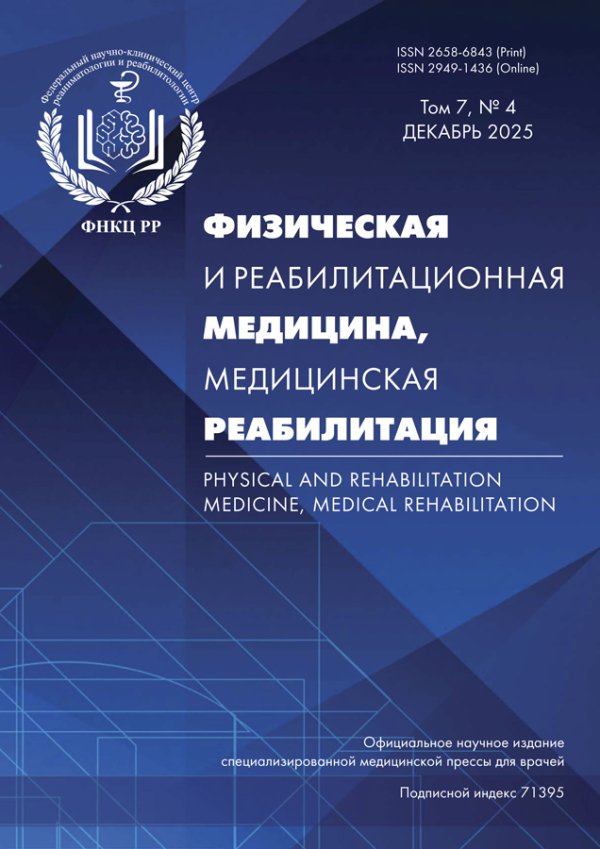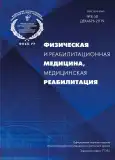Correction of cerebral thermal balance disruption in therapy and rehabilitation of patients with cerebral pathology
- Authors: Shevelev OA1,2, Petrova MV1,2, Saidov S.K.1, Chubarova MA1, Usmanov ES.1, Pranil Pradkhan -1,2
-
Affiliations:
- Federal Research and Clinical Center of Intensive Care Medicine and Rehabilitology
- «Peoples Friendship University of Russia»
- Issue: Vol 1, No 4 (2019)
- Pages: 56-63
- Section: Articles
- URL: https://journal-vniispk.ru/2658-6843/article/view/19218
- DOI: https://doi.org/10.36425/2658-6843-2019-4-56-63
- ID: 19218
Cite item
Full Text
Abstract
Full Text
##article.viewOnOriginalSite##About the authors
O A Shevelev
Federal Research and Clinical Center of Intensive Care Medicine and Rehabilitology; «Peoples Friendship University of Russia»
Email: shevelev_o@mail.ru
M V Petrova
Federal Research and Clinical Center of Intensive Care Medicine and Rehabilitology; «Peoples Friendship University of Russia»
Sh Kh Saidov
Federal Research and Clinical Center of Intensive Care Medicine and Rehabilitology
Email: shavkat_fmba@mail.ru
M A Chubarova
Federal Research and Clinical Center of Intensive Care Medicine and Rehabilitology
E Sh Usmanov
Federal Research and Clinical Center of Intensive Care Medicine and Rehabilitology
- Pranil Pradkhan
Federal Research and Clinical Center of Intensive Care Medicine and Rehabilitology; «Peoples Friendship University of Russia»
References
- Mrozek S, F.Vardon, T. Geeraerts Brain Temperature: Physiology and Pathophysiology after Brain Injury. Anesthesiology Research and Practice. V.2. 2012; 1-13.
- Cairns C. J., Andrews P. J. Management of hyperthermia in traumatic brain injury. Current Opinion in Critical Care, V. 8, N 2. 2002; 106-110.
- Greer D. M., Funk S. E., Reaven N. L., Ouzounelli M., Uman G. C. Impact of fever on outcome in patients with stroke and neurologic injury: a comprehensive meta-analysis. Stroke, V. 39, N 11. 2008; 3029-3035/
- Fernandez A., Schmidt J. M., Claassen J. et al. Fever after subarachnoid hemorrhage: risk factors and impact on outcome. Neurology. V. 68. N 13/ 2007: 1013-1019.
- Рекомендации “European Resuscitation Council” пересмотра 2015 г.
- Mcilvoy L. Comparison of brain temperature to core temperature: a review of the literature. Journal of Neuroscience Nursing. V. 36. 2004; 1-23.
- Soukup J., Zauner A., Doppenberg E.M.R. et al. The importance of brain temperature in patients after severe head injury: relationship to intracranial pressure, cerebral perfusion pressure, cerebral blood flow, and outcome. Journal of Neurotrauma, V. 19. N 5. 2002; 559 -571.
- B. Karaszewski, J. M. Wardlaw, I. Marshall et al. Measurement of brain temperature with magnetic resonance spectroscopy in acute ischemic stroke. Annals of Neurology. V. 60. N 4. 2006; 438-446.
- Sokoloff L. Energetics of functional activation in neural tissues. Neurochemical Research. V. 24. N 2. 1999; 321-329.
- Kiyatkin E.A., Brown P.L., Wise R.A. Brain temperature fluctuation: a reflection of functional neural activation. European Journal of Neuroscience. V. 16. N 1. 2002; 164-168.
- Elwassif M.M., Kong Q., Vazquez M., Bikson M. Bio-heat transfer model of deep brain stimulation-induced temperature changes. J. Neural Eng. N 3. 2006; 306-315.
- Alberts B., Johnson A., Lewis J., Raff M., Roberts K., Walter P. Molecular Biology of the Cell. Garland Science, 4th edition, 2002; 12-23.
- Jessen C. Selective brain cooling in mammals and birds. Japanese Journal of Physiology. V. 51. N 3. 2001; 291-301.
- Nibo, L., Wanscher, M., Secher, N.H. Influence of intranasal and carotid cooling on cerebral temperature balance and oxygenation. Front. Physiol. V. 7. 2014; 29-37.
- Cabanac M., Brinnel H. Blood flow in the emissary veins of the human head during hyperthermia. European Journal of Applied Physiology and Occupational Physiology. V. 54. N 2. 1985; 172-176.
- Бутров А.В., Шевелев О.А.,Чебоксаров Д.В., Ходорович Н.А. Неинвазивное суточное термокартирование головного мозга в динамике ишемического инсульта при краниоцеребральной гипотермии. Вестник РУДН, серия медицина, 2012. № 7. 62-64.
- Mariak Z., White M.D., Lewko J., Lyson T., Piekarski P. Direct cooling of the human brain by heat loss from the upper respiratory tract. Journal of Applied Physiology. V. 87/ N 5. 1999; 1609-1613.
- Obdulia L., Bayazitoglu Y. Effect of physiology on the temperature distribution of a layered head with external convectionInternational. Journal of Heat and Mass Transfer. N 46. 2003; 3233-3241.
- Бутров А.В., Шевелев О.А., Чебоксаров Д.В. Термомониторинг головного мозга в остром периоде ишемического инсульта. Ж-л Эфферентная терапия. Т. 19. №2. 2013; 61 -62.
- Sharma, H.S. Hyperthermia induced brain oedema: Current status & future Perspectives. Indian J Med Res. N 123. 2006; 629-652.
- Bain, A.R., Morrison, S.A., Ainslie, P.N. Cerebral oxygenation and hyperthermia. Front Physiol. N 5(92). 2014; 321-342.
- Nielsen, B., Savard, G., Richter, E.A., Hargreaves, M., Saltin, B. Muscle blood flow and metabolism during exercise and heat stress. J Appl. Physiol. V. 69. 1990. 1040-1046.
- Nybo, L Brain temperature and exercise performance. Experimental physiology. N 97(3). 2011; 333-339.
- Nybo, L., Nielsen, B. Middle cerebral artery blood flow velocity is reduced with hyperthermia during prolonged exercise in humans. J Physiol. V. 534. 2001; 279-286.
- Nybo, L. CNS fatigue provoked by prolonged exercise in the heat. Front Biosci (Elite Ed) V. 2. 2010; 779-792.
- Ansley, L., Marvin, G., Sharma, A., Kendall, M.J., Jones, D.A., Bridge, M.W. The effects of head cooling on endurance and neuroendocrine responses to exercise in warm conditions. Physiological Research. V. 12. 2015; 76 - 82
- Муравский А.В., Дехтярев Ю.П., Колосовский С.А. Особенности МРТ изменений у боксеров, перенесших повторные черепномозговые травмы. Информационный порта «Спортивная медицина». www.sportmedicine.ru
- Конов А.В., Шевелёв О.А., Смоленский А.В. с соавт. Использование локальной терапевтической краниоцеребральной гипотермии для профилактики осложнений лёгкой черепно-мозговой травмы в спорте. Ж-л «Терапевт» № 11-12. 2015; 21-28.
- Campos F., Perez-Mato M., Agulla J., Blanco M. et al. Glutamate excitoxicity is the key molecular mechanism which is influenced by body temperature during the acute phase of brain stroke. 2012; doi :10.1371. journal.pone.0044191 http://nrs.harvard.edu/urn-:HUL.
- Гусев Е.И., Скворцова В.И. Ишемия головного мозга, Мед., Москва, 2001, С. 328.
- Diringer M., Nancy L., Funk S., Uman G. Errarum tlevated body temperature independently contributes to increased length of stay in neurologic intensive care unit patients. Critical Care Medicine. V. 32. 2004; 1489-1495.
- Campos F., Sobrino T., Vieites-Prado A., Perez-Mato M. et al. Hyperthermia in Human Ischemic and Hemorrhagic Stroke: Similar Outcome, Different Mechanisms. PLoS ONE 11/2013; 8(11):e78429. doi: 10.1371/journal.pone.0078429.
- Whiteley W.N., Thomas R., Lowe G., Rumley A. et al. Do acute phase markers explain body temperature and brain temperature after ischemic stroke? Neurology. V. 79(2). 2012; 152-158.
- Rossi S., Roncati E., Zanier, I., Mauri, A. et al. Brain temperature, body core temperature, and intracranial pressure in acute cerebral damage. Journal of Neurology Neurosurgery and Psychiatry. V. 71. N. 4. 2001; 448-454.
- Mellergard P. Intracerebral temperature in neurosurgical patients: intracerebral temperature gradients and relationships to consciousness level. Surgical Neurology. V. 43. N 1. 1995; 91-95.
- Cady E.B., D'Souza P.C., Penrice J., Lorek A. The estimation of local brain temperature by in vivo 1H magnetic resonance spectroscopy. Magnetic Resonance in Medicine. V. 33. N 6. 1995; 862-867.
- Kuroda K., Takei N., Mulkern R.V. et al. Feasibility of internally referenced brain temperature imaging with a metabolite signal. Magnetic Resonance in Medical Sciences. V. 2. N 1. 2003; 17-22.
- B. Karaszewski, J. M. Wardlaw, I. Marshall et al., “Measurement of brain temperature with magnetic resonance spectroscopy in acute ischemic stroke,” Annals of Neurology, vol. 60, no. 4, pp. 438-446, 2006.
- Сельский А.Г., Фишер А.М., Дубынина В.П., Гуляев Ю.В., Богдасаров Ю.Б., Зайцева Т.Ю., Ленская О.П., Платонов С.А., Плющев В.А., Хитров М.Л., Ширяев С.В., Шурыгин О.Ю.,Щербаков М.И., “Возможности применения динамического термокартирования в радио- и инфракрасном диапазоне в онкологической клинике” -Радиотехника, 1995г., №9, с.85-89.
- Cheever E. A., Foster K.R., “Microwave Radiometry in Living Tissue: What Does it Measure?”, IEEE Trans. Biomed. Engineering, vol. 39, pp. 563-867, June 1992.
- Чебоксаров Д.В., Бутров А.В., Шевелев О.АП. с соавт. Диагностические возможности неинвазивного термомониторинга головного мозга. Ж-л Анестезиология и реаниматология. №1. 2015; 66 - 69.
- Колесов С.Н., Воловик М.Г., Кравец П.Я. Тепловидение и радиотермометрия при черепно-мозговой травме, в кн. Клиническое руководство по черепно-мозговой травме под ред. Коновалова А.Н., Москва, «Антидор», 1998, с. 429-439.
- Чебоксаров Д.В., Шевелев О.А., Бутров А.В., Бунтина М.А. Влиние острой фокальной ишемии на температурный баланс головного мозга. Вестник РУДН, серия медицина. №3. 2014; 12 - 20.
- Faridar A.,Bershad E. M., Emiru T e al. Therapeutic hypothermia in stroke and traumatic brain injury//Frontiers in neurology, V. 2, ISSN:1664-2295.
- Григорьев Е.В., Шукевич Д.Л., Плотников Г.П., Тихонов Н.С. Терапевтическая гипотермия: возможности и пермспективы// Клиническая медицина №9, 2014, С. 9-16.
- Rzechorzek N.M., Connick P., Patani R., Selvaraj B.T., Chandrana S. Hypothermic Preconditioning of Human Cortical Neurons Requires Proteostatic Priming//EBioMedicine. 2015 Jun; 2(6): 528-535.
- Rzechorzek N. M. Hypothermic preconditioning in human cortical neurons: coupling neuroprotection to ontogenic reversal of tau// Edinburgh Research Archive, 2015.
- Murry C.E., Jennings R.B., Reimer K.A. Preconditioning with ischemia: A delay of lethal cell injury in ischemic myocardium // Circulation. -1986. - Vol. 74. - P. 1124-1136.
- Khoury N., Koronowski K.B. Perez-Pinzon M.F. Long-term window of ischemic tolerance: An evolutionarily conserved form of metabolic plasticity regulated by epigenetic modifications? J Neurol Neuromedicine. 2016; 1(2): P. 6-12.
- Stenzel-Poore MP, Stevens SL, Simon RP: Genomics of preconditioning. Stroke 2004, 35: 2683-2686. 10.1161/01.STR.0000143735.89281. bbPubMedGoogle Scholar.
- Khoury N, Xu J, Stegelmann S.D., Jackson C.W, Koronowski K.B., Dave K.R., Young J.I., Perez-Pinzon M.A. Resveratrol Preconditioning Induces Genomic and Metabolic Adaptations within the Long-Term Window of Cerebral Ischemic Tolerance Leading to Bioenergetic Efficiency. Mol Neurobiol. 2019 Jun;56(6):4549-4565. doi: 10.1007/ s12035-018-1380-6.
- Jackson CW, Escobar I, Xu J, Perez-Pinzon MA. Effects of ischemic preconditioning on mitochondrial and metabolic neruoprotection: 5' adenosine monophosphate-activated protein kinase and sirtuins. Brain Circ 2018; 4:54-61.
- Shan Jiang,Yong Wu, De-fangFang, YingChen Hypothermic preconditioning but not ketamine reduces oxygen and glucose deprivation induced neuronal injury correlated with downregulation of COX-2 expression in mouse hippocampal slices, Journal of Pharmacological Sciences, V. 137, Issue 1, May 2018, P. 30-37.
- Бутров А.В., Шевелев О.А., Пулина Н.Н., Чебоксаров Д.В., Ходорович Н.А., Бояринцев В.В., Каленова И.Е., Шаринова И.А. Новые тенденции в применении терапевтической гипотермии при ишемическом инсульте//Вестник интенсивной терапии, приложение 1, 2016, С. 69-72.
- Van der Worp H.B., Macleod M.R., Bath P.M. e.a. EuroHYP-1: European multicenter, randomized, phase III clinical trial of therapeutic hypothermia plus best medical treatment vs. best medical treatment alone for acute ischemic stroke//Int J Stroke. 2014 Jul;9(5):642-5. doi: 10.1111/ijs.12294. 2014.
- Nibo, L., Wanscher, M., Secher, N.H. Influence of intranasal and carotid cooling on cerebral temperature balance and oxygenation Front. Physiol., 27 February 2014 | doi: 10.3389/fphys.2014.
- Шевелев О.А., Бутров А.В. Чебоксаров Д.В. Ходорович Н.А. Неинвазивное суточное термокартирование головного мозга в динамике ишемического инсульта при краниоцеребральной гипотермии//Вестник РУДН, серия Медицина, 2012, №7, С. 62-64.
- Чебоксаров Д.В., Шевелев О.А., Бутров А.В., Бунтина М.А. Радиотермометрия головного мозга при краниоцеребральной гипотермии в остром периоде ишемического инсульта. Ж-л Новости науки и техники, серия медицина, Новости анестезиологии и реаниматологии, №1, 2015; 3 - 8.
- Бутров А.В., Молчанов И.В., Петрова М.В., Кондратьев А.Н., Чебоксаров Д.В., Шевелев О.А., Шестов А.В., Каленова И.Е., Шаринова И.А. Методические рекомендации по применению медицинского изделия «АТГ-01 (аппарат терапевтической гипотермии-01)» у больных в критических состояниях Ж-л Новости науки и техники, Серия Медицина, Новости анестезиологии и реаниматологии, №3, 2014; 37-53.
Supplementary files







